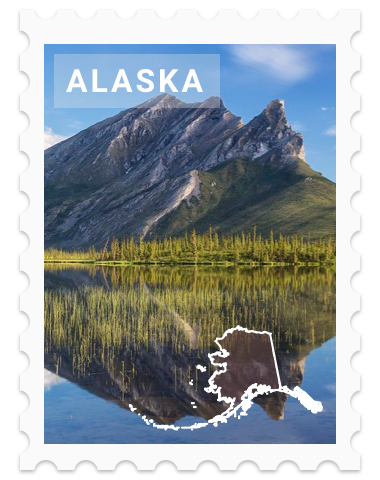Alaska
Discover Alaska

Capital
Juneau
Statehood
January 3, 1959
Long before it became the 49th state of the United States, this vast territory was home to indigenous peoples who had adapted to its challenging environment for thousands of years.
The earliest inhabitants of Alaska, including the Aleut, Inupiat, and Yupik, developed unique cultures and survival strategies perfectly suited to their surroundings. They relied on hunting, fishing, and gathering to thrive in this harsh northern climate. Their traditions and knowledge of the land were passed down through generations.
Alaska's history takes an extraordinary turn with the arrival of Russian explorers and fur traders in the 18th century. The Russian-American Company established settlements along the coast and the Aleutian Islands, seeking valuable sea otter pelts. This period of Russian influence left an indelible mark on Alaska's culture and architecture, notably evident in places like Sitka, where the Russian Orthodox Cathedral still stands.
In 1867, the United States purchased Alaska from Russia in a deal known as "Seward's Folly." At the time, critics believed the vast territory held little value, but they couldn't have been more wrong. In 1896, the Klondike Gold Rush brought prospectors and fortune seekers northward, leaving a lasting imprint on Alaska's history.
Alaska officially became a U.S. territory in 1912 and a state on January 3, 1959. Throughout the 20th century, it played a crucial role in the defense of North America during World War II and the Cold War.
Today, Alaska is celebrated for its breathtaking natural beauty. It boasts towering mountains, pristine glaciers, vast tundras, and abundant wildlife. Visitors come from around the world to witness the majesty of Denali (formerly Mount McKinley), the highest peak in North America.
Source ChatGPT
Major Airport
Ted Stevens Anchorage International Airport

Elevation
46 m
Opened
1951
Runways
3
Sticker Collection

Denali National Park
The park is centered on Denali, the highest mountain in North America.

Gates of the Arctic National Park
Slightly larger than Belgium, this expansive park is located completely north the Arctic Circle.

Glacier Bay National Park
The park preserves over 3 million acres of Southeast Alaska.

Katmai National Park
Named after Mount Katmai, a major eruption in 1912 created the Valley of Ten Thousand Smokes.

Kenai Fjords National Park
Named for its numerous fjords carved by glaciers over thousands of years.

Kobuk Valley National Park
Sitting 25 miles north of the Arctic Circle, the park preserves the Great Kobuk Sand Dunes.

Lake Clark National Park
This remote park is only accessible by boat or seaplane.

Wrangell-St. Elias National Park
The largest of the 63 US National Parks, tall mountain peaks, volcanoes, ice fields and glaciers make up this remote terrain.




